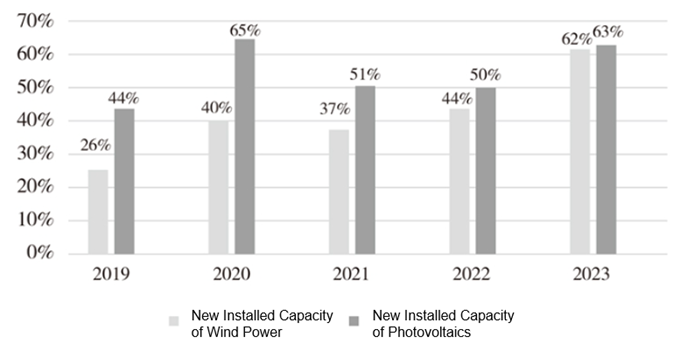所屬分類:報告與見解發佈時間:2024-09-27

Climate change has become one of the major challenges facing the world and has a profound impact on sustainable development. As the largest carbon emitter globally, China accounts for one-third of global carbon dioxide emissions and therefore bears an important responsibility in combating climate change. In recent years, China has maintained macroeconomic stability and demonstrated strong resilience. While promoting economic development, active efforts will be made to promote green transformation, commit to achieving the goal of carbon neutrality, promote ecological environment protection, improve people's livelihoods, foster international sustainable development cooperation, and implement the 2030 Agenda for Sustainable Development.
Through the implementation of a series of policies and measures, as well as international commitments, such as "China's Progress Report on Implementation of the 2030 Agenda for Sustainable Development" (hereinafter referred to as the "Report") and "Progress on the Implementation of China’s Nationally Determined Contributions (2022)" etc., demonstrating China’s deep commitment and tangible results in this field. This not only reflects China's national will, but also demonstrates its important role in global governance.
China’s efforts and contributions
· Carbon emissions and emission reduction targets
According to the "Progress on the Implementation of China’s Nationally Determined Contributions (2022)" submitted by China to the Secretariat of the United Nations Framework Convention on Climate Change [1], as of the end of 2019, China has exceeded its 2020 climate action goals ahead of schedule. In 2020, China announced that it would update and strengthen its nationally determined contribution goals: striving to peak carbon dioxide emissions before 2030 and striving to achieve carbon neutrality before 2060. By 2030, China will lower its carbon dioxide emissions per unit of GDP by over 65 percent from the 2005 level, increase the share of non-fossil fuels in primary energy consumption to around 25%, increase the forest stock volume by 6 billion cubic meters from the 2005 level, and bring its total installed capacity of wind and solar power to over 1.2 billion kilowatts. The setting of this goal not only reflects China's positive contribution to global climate governance, but also provides a solid foundation for the realization of global emission reduction goals. According to the "China's Energy Transformation" white paper, as of July 2024, China's total installed solar and wind energy capacity has reached more than 1.2 billion kilowatts six years ahead of schedule [2].
· Rapid development of renewable energy
According to the "Renewable Energy 2023" report of the International Energy Agency (IEA), China is the world’s renewables powerhouse. China accounts for almost 60% of new renewable capacity expected to become operational globally by 2028. Despite the phasing out of national subsidies in 2020 and 2021, deployment of onshore wind and solar PV in China is accelerating, driven by the technologies’ economic attractiveness as well as supportive policy environments providing long-term contracts. IEA’s forecast shows that China is expected to reach its national 2030 target for wind and solar PV installations this year, six years ahead of schedule. China’s role is critical in reaching the global goal of tripling renewables because the country is expected to install more than half of the new capacity required globally by 2030. At the end of the forecast period, almost half of China’s electricity generation will come from renewable energy sources.
According to Lianhe Green’s Analysis, China's electricity emissions account for about 50% of its total domestic carbon emissions, while China's overall carbon emissions account for approximately 30% of the global total. According to forecasts from the International Energy Agency, if half of China's electricity comes from renewable energy, the world could expect a reduction in emissions of about 8%. This would not only help reduce dependence on fossil fuels but also significantly decrease global greenhouse gas emissions.
China's Share of New Global Renewable Energy Capacity (2019-2023)

Source: China’s Energy Transition White Paper[3]
· Ecological environment protection
According to the "Report", China adheres to the concept of "Lucid waters and lush mountains are invaluable assets" and has achieved remarkable results in the construction of ecological civilization. In the past few years, China has achieved remarkable results in ecological protection. By June 2022, 1.2 million forest chiefs at various levels had been appointed. By 2021, China’s forest area reached 231 million hectares, with a forest coverage rate of 24.02%. Both forest area and stock continued to grow, making China the country with the fastest growth in forest resources in the world, contributing a quarter of the world’s new forest area. In addition, with active support of the Chinese government, the first phase of the Fifteenth Conference of the Parties (COP15) to the Convention on Biological Diversity was convened in Kunming, Yunnan Province, in October 2021. The Kunming Declaration was issued and the Kunming Biodiversity Fund established. In December 2022, as the President, China facilitated the convening of the second phase of COP15 in Montreal, Canada, where the Kunming-Montreal Global Biodiversity Framework and the Global Biodiversity Framework Fund were established. As the largest donor among developing countries, China contributed USD31.9 million to the eighth replenishment of the Global Environment Facility (GEF), helping GEF-8 realize the largest ever capital increase of USD5.33 billion [4].
· Water resources management and ocean protection
According to information from the Ecological and Environmental Protection Report, China ensures water supply for nearly 20% of the global population with only 6% of the world’s freshwater resources, and has made positive progress in implementing water-related Sustainable Development Goals (SDGs). As of the end of 2022, 6.78 million rural water supply projects have been built across the country, serving a rural population of 870 million people, and the rural tap water penetration rate has reached 87%. In 2023, the proportion of sections with excellent surface water quality (Category I-III) across the country will be 89.4%, a year-on-year increase of 1.5 percentage points; the overall seawater quality in coastal waters will maintain an improving trend, and the proportion of seawater sections with excellent (Category I and II) seawater quality will be 85.0%. , a year-on-year increase of 3.1 % . In order to further rectify black and smelly water bodies , the state has carried out spot inspections and follow-up supervision to promote the elimination rate of black and smelly water bodies in county-level cities to more than 70% [5]. China continues to ensure the safety of drinking water, promotes the construction of a water-saving society, improves water resource utilization efficiency, and is committed to water resources management and ocean protection.
· International cooperation and responsibility
According to the "Report", China promotes international cooperation and achieves mutual benefit and win-win results through the "Belt and Road" initiative. In the past ten years, since it was proposed, the BRI has stimulated investments worth nearly USD one trillion, launched more than 3,000 cooperation projects, created 420,000 jobs for participating countries, and lifted nearly 40 million people out of poverty. In the future, China will continue to strengthen cooperation with the international community to jointly respond to climate change. It plans to establish a global development promotion center, build a platform for international cooperation, share sustainable development experience, promote cooperation in areas such as poverty reduction and energy transformation, and achieve Sustainable Development Goals.
Looking forward to future development
Lianhe Green believes that China's efforts in addressing climate change and promoting sustainable development have achieved remarkable results. In the future, China will continue to increase investment, deepen green transformation, promote the development of renewable energy, and promote international cooperation. Climate change and sustainable development cannot be achieved by a single country alone; if one country reduces emissions while other countries continue to increase emissions, it is impossible for the world to achieve carbon neutrality, and extreme weather and global warming cannot be effectively mitigated. Therefore, countries must work together to jointly invest in sustainable and climate projects to build a better world and achieve the common goal of carbon neutrality.
The above is only a partial analysis of China’s contribution to climate change and sustainable development. Lianhe Green hopes to provide Hong Kong and international investors with more analytical perspectives through our services in the field of green finance, helping them better understand the green financial products, ESG ratings and sustainability reports issued by Chinese companies. Through win-win cooperation, the world will respond to climate change more effectively and realize the vision of sustainable development.


